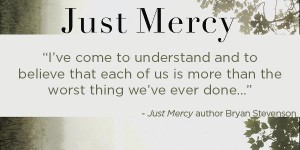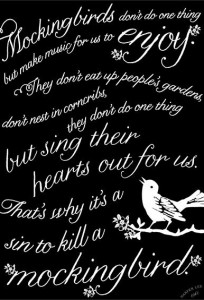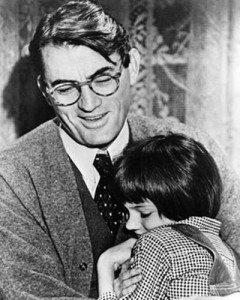by Katharyn Jones
DISCLAIMER: This post has nothing to do with how to hunt or kill mockingbirds. However, this post will make you question life as you know it.
My initial memories of To Kill a Mockingbird are intertwined with recollections of pimples, hormones, and weird body changes. I first encountered Harper Lee’s influential novel after being assigned the book for my 8th grade English course. The book both fascinated and daunted me. After all, the were words like assuaged on the first page! (I must admit I was too lazy to look it up in the dictionary.) Despite the occasional “big word,” My 8th grade self got caught up in the story and the spunk of a young girl called Scout who dared to do the things I only dreamed of– like cussing at the dinner table! (My mother would never have allowed that!)
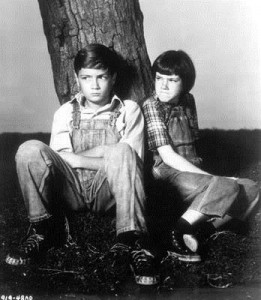
The mystery and strangeness of Lee’s narrative seemed to me to echo the weirdness of the transition into the adult world. To Kill a Mockingbird was full of fun and exciting turns that kept me turning the next page when I was younger. However, sometimes I wonder if missed something.
That’s right. I think I missed something.
The spookiness, the humor, the twisted feeling in the pit of my stomach, and the infamous request to “pass the damn ham, please” are all elements of the book that stuck with me in the years beyond the course. But, as Lee wrote in her book, “People generally see what they look for, and hear what they listen for.” As an emotional adolescent, I guess I fixated on the emotions of the story. How the book made me feel. But Lee’s only book did not become an instant classic without having a little something more to offer readers than a gamut of feelings.
I am now a senior in college studying English Literature, and I never thought to revisit To Kill a Mockingbird until I heard of its recent selection for The Big Read coming up this November in Holland, Michigan. At first, I was disappointed with the selection. Really? To Kill a Mockingbird?! Why should I read that book again? (It might make me recount the horrors of Jr. High school!) But, being the model English student that I am, I decided to grit my teeth and jump–once again– into the small-town world of Maycomb, Alabama.
It blew me away.
The great storyline remained, but there where all of these additional layers of problems that confront not only the world of Scout (a.k.a. Jean Louise Finch), but also the problems of the world I live in today. Lee raises pertinent questions about race, class, gender, justice, and the essence of being human. I am left wondering if my world has really changed all that much since Lee sat down to write her book. Our country and our world is still grappling with some of these issues. How are we to stand up and address these things with COURAGE? After all, I am not a lawyer out to defend the innocent.
On reading To Kill a Mockingbird for a second time, I found myself caught up with some advice Atticus Finch gave instead of his daughter’s use of questionable language at the dinner table. Atticus encourages his daughter to try and think about life from another person’s perspective and remarks:
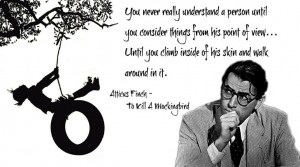
Attempting to see life through another person’s eyes can be uncomfortable, but it is through these small steps of courage that we are able to engage in meaningful dialogue about the problems of our society. Being able to take part in this sort of discussion is the best motivation for taking a second look at To Kill a Mockingbird. Forget memories of pimples and your boring high school English teacher. Throw away all of your preconceived notions about the book and courageously open up Lee’s masterpiece once again! It will coerce you to laugh… maybe even cry, but, most importantly it will make you THINK. If you are not sure where to start, make the Holland Big Read event November 2014 your excuse for giving the book another chance. And, who knows! Maybe–like me– you will discover a better and more applicable story than you ever read in high school. (Especially, if you used SparkNotes instead of reading the novel in the first place!)
For, in the words of the impish Scout, “Until I feared I would lose it, I never loved to read. One does not love breathing.” It is just necessary to live.

